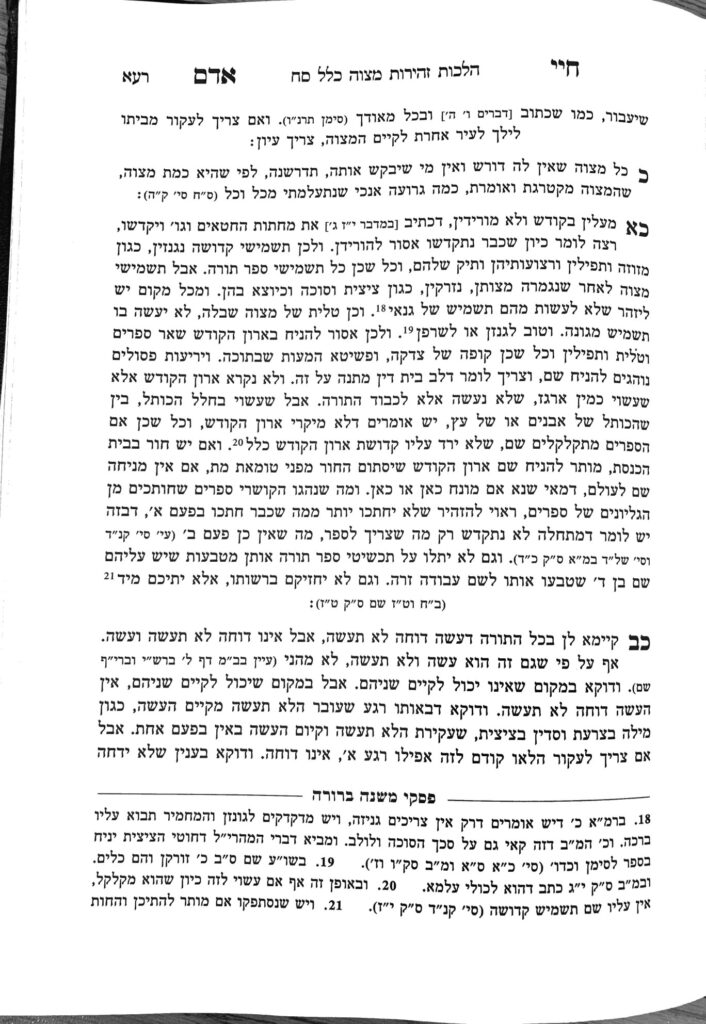We are continuing in siman 21, regarding the concept of ma’alin bakodesh. We will continue to discuss situations of misusing tashmishei kedusha.
In siman 154, the Mishnah Berurah writes that it is assur to use a sefer to block the sun. However, there is an argument that it is muttar to place a one sefer under another sefer in order to raise the first sefer, because it is part of learning and makes the learning better. If the first sefer was already there, so the person learning did not move it for the purpose of lifting his current sefer, everyone agrees it is muttar. Similarly, if the purpose of using a sefer to block the sun is in order to learn, it would be muttar.
If a person wishes to line a blank piece of paper, even for the purpose of learning, they should not do it on top of a sefer. Similarly, one should not write chiddushei torah on top of a sefer. However, one can rely on lev bais din, if necessary, to write chiddushei torah on top of a sefer.
If one wishes to store papers in a sefer, if they are divrei torah, it is muttar, but if it is blank paper, it is assur. Similarly, if one needs to write a non-torah related note, they should not do it on top of a sefer.
A bookcase designated for the purpose of seforim should arguably be considered a tashmish of kedusha, and assur to use for other purposes. However, the Mishnah Berurah says that we consider the binding of a sefer to be a tashmish of kedusha (and not part of the sefer itself) so the bookcase becomes a tashmish d’tashmish. However, it follows that seforim which are not bound, such as small booklets or loose notes, would make the bookcase into a tashmish of kedusha, and it would be a problem to use the bookcase for other items. If one made a explicit tenai that the bookcase not be designated only for seforim, the tenai would work, as we have learned previously (shiur 1457).
Falling asleep on a sefer should be assur, because it is using the sefer as a pillow. However, Rav Yosef Chaim Sonnenfeld writes in a teshuva that one does not have to wake the sleeping person, because since it is something that can occur when learning, there is a lev bais din concept to permit it.
The Mishnah Berurah mentions that some have the minhag to place other items in a sefer. For example, some people have the minhag to use old tzitzis strings as bookmarks. Since it is part of the use of the sefer for learning, it is muttar. However, storing other items is a problem, as we have learned above.
It is important to note that the Mishnah Berurah writes that the source of the concept of lev bais din is a teshuva from the Terumas Hadeshen. In the Teshuva, the Terumas Hadeshen writes that the concept is lev bais din is his limmud zechus to explain what people do. However, it is preferable that rather than rely on his limmud zechus, a person speak out an explicit tenai, as we have learned previously.
Summary
- It is assur to use a sefer to block the sun or to raise something else. However, it is muttar for the purposes of learning.
- It is assur to write notes on top of a sefer, but one can rely on the lev bais din for the purpose of writing chiddushei torah.
- One should not store papers in a sefer unless they are torah related.
- A bookcase can be used to store other items, unless the seforim on the shelves do not have binding. If one makes a tenai before usage, it is muttar even when the seforim are not bound.
- One can rely on the lev bais din to allow someone who fell asleep on their sefer to remain sleeping.
- It is muttar to place items in a sefer for the purpose of learning, such as a bookmark, but not for other purposes.
- It is preferable not to rely on the lev bais din but rather to make an explicit tenai before beginning to use the item.



